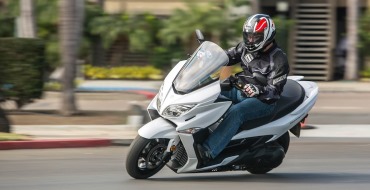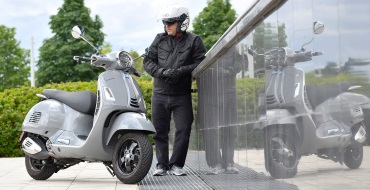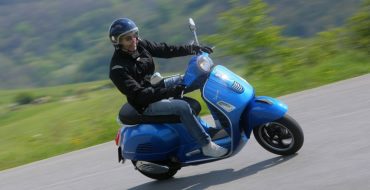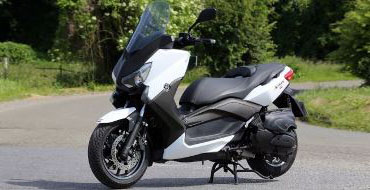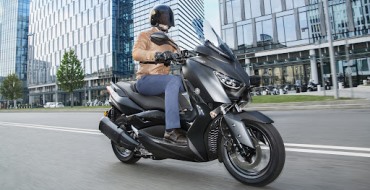 Yamaha XMax YP400RA - Owner's Manual > Operation and important riding points
Yamaha XMax YP400RA - Owner's Manual > Operation and important riding points
Read the Owner's Manual carefully to become familiar with all controls. If there is a control or function you do not understand, ask your Yamaha dealer.
WARNING
Failure to familiarize yourself with the controls can lead to loss of control, which could cause an accident or injury.
TIP
This model is equipped with a lean angle sensor to stop the engine in case of a turnover. In this case, the multi-function display indicates error code 30, but this is not a malfunction. Turn the key to "OFF" and then to "ON" to clear the error code. Failing to do so will prevent the engine from starting even though the engine will crank when pushing the start switch.
In order for the ignition circuit cut-off system to enable starting, the sidestand must be up.
1. Turn the key to "ON".
The following warning light, indicator light and indicators should come on for a few seconds, then go off.
- Engine trouble warning light
- ABS warning light (for ABS models)
- Immobilizer system indicator light
- V-belt replacement indicator
- Oil change indicator
2. Close the throttle completely.
3. Start the engine by pushing the start switch while applying the front or rear brake.

- Rear brake lever
- Front brake lever
- Start switch
If the engine does not start, release the start switch, wait a few seconds, and then try again. Each starting attempt should be as short as possible to preserve the battery. Do not crank the engine more than 10 seconds on any one attempt.
NOTICE
For maximum engine life, never accelerate hard when the engine is cold!
Starting off
1. While pulling the rear brake lever with your left hand and holding the grab bar with your right hand, push the scooter off the centerstand.

- Grab bar
2. Sit astride the seat, and then adjust the rear view mirrors.
3. Switch the turn signals on.
4. Check for oncoming traffic, and then slowly turn the throttle grip (on the right) in order to take off.
5. Switch the turn signals off.
Acceleration and deceleration

The speed can be adjusted by opening and closing the throttle. To increase the speed, turn the throttle grip in direction (a). To reduce the speed, turn the throttle grip in direction (b).
Braking
WARNING
- Avoid braking hard or suddenly (especially when leaning over to one side), otherwise the scooter may skid or overturn.
- Railroad crossings, streetcar rails, iron plates on road construction sites, and manhole covers become extremely slippery when wet. Therefore, slow down when approaching such areas and cross them with caution.
- Keep in mind that braking on a wet road is much more difficult.
- Ride slowly down a hill, as braking downhill can be very difficult.
1. Close the throttle completely.
2. Apply both front and rear brakes simultaneously while gradually increasing the pressure.
Front

Rear

Tips for reducing fuel consumption
Fuel consumption depends largely on your riding style. Consider the following tips to reduce fuel consumption:
- Avoid high engine speeds during acceleration.
- Avoid high engine speeds with no load on the engine.
- Turn the engine off instead of letting it idle for an extended length of time (e.g., in traffic jams, at traffic lights or at railroad crossings).
Engine break-in
There is never a more important period in the life of your engine than the period between 0 and 1600 km (1000 mi). For this reason, you should read the following material carefully.
Since the engine is brand new, do not put an excessive load on it for the first 1600 km (1000 mi). The various parts in the engine wear and polish themselves to the correct operating clearances.
During this period, prolonged full-throttle operation or any condition that might result in engine overheating must be avoided.
0-1000 km (0-600 mi)
Avoid prolonged operation above 4000 r/min. NOTICE: After 1000 km (600 mi) of operation, be sure to replace the engine oil, final transmission oil and the oil filter element.
1000-1600 km (600-1000 mi)
Avoid prolonged operation above 6000 r/min.
1600 km (1000 mi) and beyond
The vehicle can now be operated normally.
NOTICE
- Keep the engine speed out of the tachometer red zone.
- If any engine trouble should occur during the engine break-in period, immediately have a Yamaha dealer check the vehicle.
Parking
When parking, stop the engine, and then remove the key from the main switch.
WARNING
- Since the engine and exhaust system can become very hot, park in a place where pedestrians or children are not likely to touch them and be burned.
- Do not park on a slope or on soft ground, otherwise the vehicle may overturn, increasing the risk of a fuel leak and fire.
- Do not park near grass or other flammable materials which might catch fire.
See also:
 Yamaha XMax YP400RA - Owner's Manual > For your safety - pre-operation checks
Yamaha XMax YP400RA - Owner's Manual > For your safety - pre-operation checks
Inspect your vehicle each time you use it to make sure the vehicle is in safe operating condition. Always follow the inspection and maintenance procedures and schedules described in the Owner's Manual.
 Yamaha XMax YP400RA - Owner's Manual > Periodic maintenance and adjustment
Yamaha XMax YP400RA - Owner's Manual > Periodic maintenance and adjustment
Periodic inspection, adjustment, and lubrication will keep your vehicle in the safest and most efficient condition possible. Safety is an obligation of the vehicle owner/operator. The most important points of vehicle inspection, adjustment, and lubrication are explained on the following pages.




